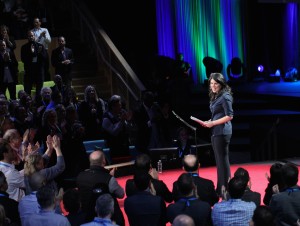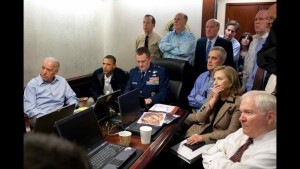Monica Lewinsky’s Resurfacing — Political Transparency
Posted: April 10, 2015, 5:18 p.m.
by Kaitlin Goins.
 It’s 1998, and 22-year-old Monica Lewinsky is an intern at the White House. She has the dream internship working underneath the most powerful man in the world . . . did I mention she is “in love with her boss.” Do the words Bill Clinton, Lewinsky Scandal, Blue Dress, or perhaps “I did not have sexual relations with that woman” ring a bell?
It’s 1998, and 22-year-old Monica Lewinsky is an intern at the White House. She has the dream internship working underneath the most powerful man in the world . . . did I mention she is “in love with her boss.” Do the words Bill Clinton, Lewinsky Scandal, Blue Dress, or perhaps “I did not have sexual relations with that woman” ring a bell?
Back to the present . . . Lewinsky, now 41, is once again in the news. In a TED talk, Lewinsky described her 22nd year as a time that her parents feared she would be “humiliated to death, literally.” Lewinsky labeled herself the first victim of cyberbullying.
So what does Lewinsky resurfacing have to do with public relations, communications or anything? There are a number of reasons why this scandal is still relevant today, but I’ll only touch one: transparency in the political arena.
Transparency in the White House
Now I admit, there are as many reasons for the White House to be less transparent as there are for it to be transparent. For instance, national security. On one hand, I want to know where all my tax dollars are going. On the other hand, I don’t want other countries to know exactly where all of the taxpayers’ dollars are going.
At a time when we are looking at potential frontrunners for the seats in the White House, we have to consider communications by the president and his cabinet. How will they handle crises such as the Lewinsky Scandal? On a larger scale, how will they handle crises such as 9/11, the Cuban Missile Crisis, World Wars I and II?
Are the standards of communication for the White House at an appropriate level? Are they higher, on-par or lower than the levels of communication we expect from corporations? Should those standards be different because of national security?
With each president comes a new communications team, which means these standards consistently change every four or eight years. Personally, I prefer the president to be in the center of the situation with sleeves rolled up rather than stiffly standing behind the official White House podium in a suit: for instance, George W. Bush with bullhorn in hand at Ground Zero four days after 9/11, or President Obama in Tuscaloosa, Alabama, surveying the damage after the April 27 tornadoes that killed 318 people across eight states. Even President Obama in the White House’s Situation Room when U.S. Navy Seals shot and killed Osama bin Laden is comforting.
 These instances prove not only does the president have a plan, but he is also actively working to solve the problem. Standing behind the podium allows for control, planned speeches, and for all the information to get out at once. However, the impromptu — or maybe not-so impromptu — instances assure me that the president actually knows what is going on and is doing something about it. Sometimes those official press conferences that interrupt our nightly television programs seem a little too cavalier.
These instances prove not only does the president have a plan, but he is also actively working to solve the problem. Standing behind the podium allows for control, planned speeches, and for all the information to get out at once. However, the impromptu — or maybe not-so impromptu — instances assure me that the president actually knows what is going on and is doing something about it. Sometimes those official press conferences that interrupt our nightly television programs seem a little too cavalier.
So, if the president and the White House should have different standards of communication, how different should those standards be?
Transparency by political candidates
Hillary Clinton is an expected frontrunner for the 2016 Democratic seat in the race for the presidency. While Hillary has already said before that thoughts of Lewinsky do not keep her up at night, should they? The Clinton name — both Hillary’s and Bill’s — has been in the news consistently since his presidency and even more frequently as of late. And I’m a little concerned.
Bill Clinton has been less than honest in the past: “I have not had sexual relations with that woman” (insert finger-shaking from behind the official podium). He completely lied in his now-famous quote. Not OK, Mr. President . . . Hillary, too, has been less-than-honest in her career (Travelgate, Whitewater and Vince Foster Scandals — to name a few). I’m not completely convinced all 31,000 of those emails were personal.
I’m not saying she should have published them all for us to read, but I am saying every single email on her personal server should have been handed over to the United States government. Sorry, Mrs. former secretary of state and first lady, but I’m a bit concerned that you just deleted the ones you didn’t think they needed.
With the political season gearing up, we — as citizens — should be gearing up, too. What is the definition of transparency for political races? During the 2008 elections, controversy brewed over whether President Obama should be required to release his birth certificate. How much is too much? If a candidate is not transparent in his or her campaign, you can almost bet he or she will not be transparent in office. But, at the same time, political mudslinging gets dirty, and I’m not sure I care to see every document that could potentially put either opponent in chains.
Lewinsky’s resurfacing has resurfaced questions about the Clintons and transparency in the White House and in political races. What is transparency in political communications? I’m interested to see how the presidential race rolls out, especially if Hillary Clinton decides to throw her ring into the fire. How will Monica Lewinsky, the email scandal and other controversies surrounding the Clintons affect Hillary’s campaign? We shall see . . .
Opinions
Comments are closed.






Post comment
This post was very well organized and fairly interesting. The use of the Clinton-Lewinsky scandal was a great way to draw in readers. It is interesting that this scandal has resurfaced these questions, although I personally feel like Lewinsky is only using Clinton’s choice to run for president as a way to ease her way back into the spotlight. I definitely agree with the ideology that as President they should show a certain level of transparency but not enough that would put the country at risk. Overall this is a great post!
Permalink